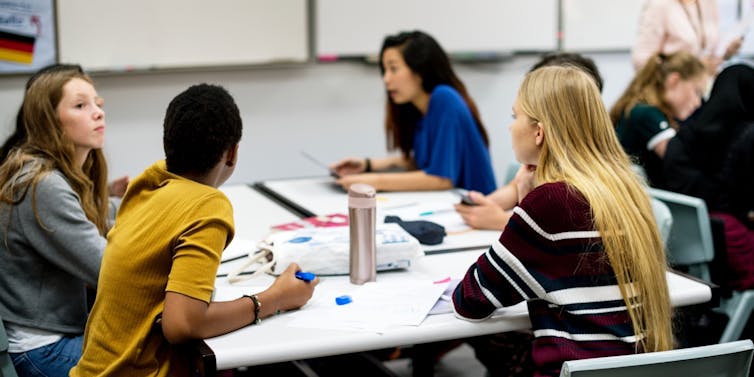Source: The Conversation – UK – By Eleftheria Kodosaki, Research Fellow in Neuroimmunology, UCL

A new test could help to diagnose memory issues associated with Alzheimer’s disease in as little as three minutes. According to recently published findings the test, called the Fastball EEG test, may one day help doctors flag people who need further checks for Alzheimer’s disease without the need for unnecessary waits or time-consuming procedures.
Alzheimer’s disease affects millions of people worldwide. It’s a progressive condition, in which brain cells are slowly damaged and die – leading to memory loss, confusion and difficulties with thinking and daily tasks.
The disease process begins long before symptoms manifest. Proteins called amyloid and tau gradually build up in the brain, forming plaques and tangles that interfere with communication between nerve cells. By the time memory problems are significant enough for diagnosis, much of the damage has already been done.
It’s important to note that the signs of Alzheimer’s disease and symptoms don’t develop similarly in all patients. This means the amount of amyloid plaques and tau tangles a person has in their brain doesn’t always match the severity of the disease.
In addition, the amount of plaques and tangles can only be estimated via imaging or blood tests. These factors make Alzheimer’s disease difficult to diagnose and predict how it will progress. This is why researchers are keen to develop tests that can spot signs of the disease earlier.
Traditionally, diagnosis has relied on cognitive screening tests, where a doctor asks a patient to remember words, copy drawings or complete problem-solving tasks. These tools are effective, but take time and require trained staff. They may also be stressful for the patients and can be influenced by factors such as a person’s education level, their language skills or test-related performance anxiety.
More advanced diagnostic options, including brain scans and laboratory analysis of cerebrospinal fluid (a fluid which protects the brain and spinal cord), can indicate the presence of Alzheimer’s disease in the brain. But these tests are expensive and invasive.
But the Fastball EEG test uses a different approach.
Instead of asking patients to actively recall or solve problems, it measures how the brain responds to images flashed on a screen. Participants first see a set of eight pictures, which they’re asked to name but not memorise.
Then, during the test, hundreds of images are shown in quick succession – around three per second. Every fifth image is one of the eight previously shown. The EEG headset records the brain’s electrical activity, picking up tiny signals that reveal whether the brain recognises these familiar images.
In healthy people, the recognition response is clear. But in people with mild cognitive impairment (problems with thinking, memory or problem-solving which often precedes Alzheimer’s disease) and especially those with memory issues, the response is weaker.
To understand the test’s suitability, researchers recruited 106 participants to their study. This included 54 healthy adults and 52 people with mild cognitive impairment (MCI). Among the latter group, some had memory-specific problems (amnestic MCI), while others had difficulties unrelated to memory – such as problems with attention (non-amnestic MCI).

nobeastsofierce/ Shutterstock
The researchers found that the Fastball test was sensitive enough to distinguish between these groups. Those with amnestic MCI showed significantly reduced brain responses to the familiar images compared to healthy adults and those with non-amnestic MCI. In other words, the test quickly identified the kind of memory impairment most closely linked to early Alzheimer’s.
They then repeated the test a year later. Some of the participants who’d only had mild cognitive impairment in the first test had progressed to either Alzheimer’s disease dementia or another type of dementia, called vascular dementia, which manifests in symptoms similar to Alzheimer’s.
The researchers also asked the participants who developed dementia to perform the standard cognitive tests currently used to diagnose Alzheimer’s. These participants showed no or little difference in this test, which means the test wasn’t sensitive enough to detect the transition from mild cognitive impairment to dementia. But with the Fastball test, the participants performed marginally worse than they had previously.
However, of the 42 participants with mild cognitive impairment who repeated the Fastball test a year later, only eight had transitioned to dementia. So, although the results are very promising in illustrating the test’s accuracy, they should be interpreted with caution as they’re based on a small number of people.
The future of diagnosis
Crucially, the test is fast – lasting only three minutes. It also doesn’t rely on the participant’s effort, mood or test-taking ability, which can influence cognitive test results. It can also be done at home or in a GP’s office, which might reduce anxiety for patients and make it easier to reach a larger group of people.
However, the study did not include other conditions where memory impairment is also present – such as depression or thyroid problems – so it cannot be used as a standalone diagnostic tool for Alzheimer’s disease. Future studies in more diverse populations which take these other conditions into account will be needed to better understand the test’s strengths, limitations and potential.
Other tests, which are currently in development, may be better for diagnosing Alzheimer’s disease specifically. For example, blood tests could transform Alzheimer’s diagnosis once they’re more widely rolled out.
These measure proteins linked to Alzheimer’s and can give a snapshot of disease processes happening in the brain. Some tests currently being studied would only require a finger-prick of blood. If they prove to be accurate, this could mean patients could do these tests at home and mail them in for analysis.
Tools such as the Fastball test and blood tests could help shift the focus of Alzheimer’s care from late diagnosis to early intervention. By identifying people at risk of the disease years earlier, doctors could recommend lifestyle changes, monitor patients more closely or provide them with appropriate therapies earlier, while they can still make the most difference.
![]()
Eleftheria Kodosaki does not work for, consult, own shares in or receive funding from any company or organisation that would benefit from this article, and has disclosed no relevant affiliations beyond their academic appointment.
– ref. Alzheimer’s disease: new three-minute test can spot memory issues – here’s how it works and what it can tell you – https://theconversation.com/alzheimers-disease-new-three-minute-test-can-spot-memory-issues-heres-how-it-works-and-what-it-can-tell-you-264519











